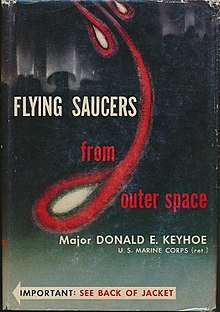Flying Saucers from Outer Space
Flying Saucers from Outer Space (Holt, 1953) is a non-fiction book by Donald Keyhoe about unidentified flying objects, aka UFOs.[2][3]
 Front cover | |
| Author | Donald Keyhoe |
|---|---|
| Subject | Flying Saucers |
| Publisher | Henry Holt[1] |
Publication date | 1953 |
Adaptation
In 1956 a science-fiction film credited as "suggested by" the book was made under the title Earth vs. the Flying Saucers, also known as Invasion of the Flying Saucers.[lower-alpha 1] The working titles of the film were Attack of the Flying Saucers, Invasion of the Flying Saucers and Flying Saucers from Outer Space. In a letter contained in the film's production file at the AMPAS Library, blacklisted screenwriter Bernard Gordon stated that he wrote the screenplay for this picture using the pseudonym Raymond T. Marcus.
gollark: If this happens right after my computers all implode, guess I just lose access to everything.
gollark: Under normal circumstances, I just buy a new one and copy data back on.
gollark: You should buy the nonexplosive kind.
gollark: Yes, I know flash unthingies after some time.
gollark: It's just attached to my keyring, it only gets plugged in when I need to update stuff on it.
See also
The Flying Saucers Are Real (also by Keyhoe)
References
- Leonard, Jonathan N. (November 22, 1953). "Flying Sky-High; FLYING SAUCERS FROM OUTER SPACE. By Maj. Donald E. Keyhoe. 276 pp. New York: Henry Holt & Co. $3" – via NYTimes.com.
- "UFO INVESTIGATOR, AUTHOR DONALD E. KEYHOE, 91, DIES" – via www.washingtonpost.com.
- "Donald E. Keyhoe, 91, Exponent of U.F.O.'s". December 3, 1988 – via NYTimes.com.
Notes
- Screen credits for Earth vs. the Flying Saucers are: screen play by George Worthing Yates and Raymond T. Marcus, screen story by Curt Siodmak, suggested by "Flying Saucers From Outer Space" by Major Donald E. Keyhoe. Keyhoe's descriptions of UFO reports and Air Force investigations were used to give a realistic background to a fictional story. Keyhoe's recounts of descriptions of UFOs with a stationary central cabin and rotating slotted outer disk inspired the design of the saucers in the movie.
This article is issued from Wikipedia. The text is licensed under Creative Commons - Attribution - Sharealike. Additional terms may apply for the media files.